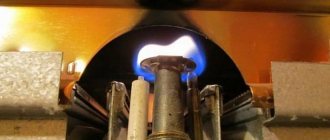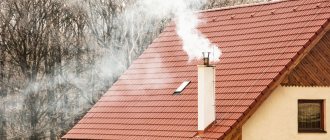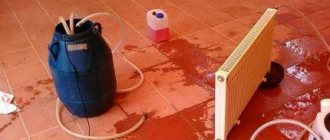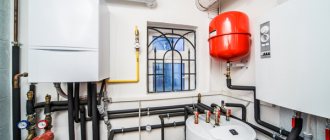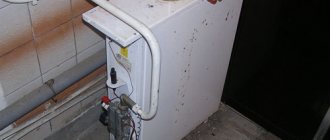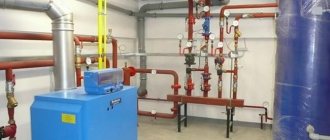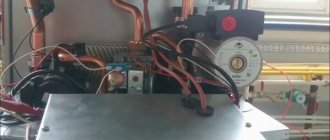When installing a gas boiler at home, the owners hope that the radiators in the rooms will be hot, and the unit itself will function stably, providing good heating in the house. However, no one is immune from breakdowns. Let's try to figure out why the gas boiler turns off and what other malfunctions may arise during the operation of the equipment.
Modern heating boilers are very reliable, but no one is immune from breakdowns. Most often, malfunctions of heating boilers arise as a result of operating errors, as well as if inaccuracies were made during installation.
If the owners notice that the equipment is not working well, and the radiators in the rooms are cold despite the fact that the boiler is set to the maximum level, you need to stop the unit and find out the cause of the problem. Most likely, you won’t be able to find out the cause of the breakdown on your own, so it’s better to immediately call a specialist from the service center.
When the boiler is turned on, a popping sound is heard
If, when you turn on the gas boiler, you hear extraneous noises: pops, clicks, knocks, you should immediately start looking for the problem.
The three-way valve is the main component of a double-circuit gas boiler. Its task is to regulate the redistribution of flows when the hot water supply is turned on. If the cause of extraneous noise lies in the valve, it is faulty and the part needs to be replaced
What to do if the gas boiler slams sharply when turned on:
- Three-way valve malfunction. This device sends water in a small circle when drawing sanitary water from taps. If it clicks, it needs to be replaced.
- Prolonged spark ignition. When ignited, the resulting excess gas flares up and a characteristic pop is heard. In this case, it is recommended to check the igniter, burner, electrode, and all contacts.
- The chimney or filter is clogged. In this case, they need to be cleaned. The chimney is checked with a lit match. If the flame deviates, everything is fine; if there is no draft, cleaning is required.
- Installation error. If the equipment is installed incorrectly, but when heated, the metal is deformed and popping sounds are heard. The same sound occurs when it cools as the metal returns to its original position. When switching to hot water supply, the boiler hums. The problem is solved by reinstalling the gas boiler.
- The injectors are clogged. A thin wire is used to clean them. You must first turn off the gas.
If the boiler vibrates during operation, it is recommended to place a gasket under the body.
What to do if the boiler turns off
Let's look at typical problems and ways to solve them.
Unsuitable power
If the boiler switches on and off frequently, it is due to excess power. Yes, yes, excess is the same problem as lack. A powerful device in a small room quickly warms up the area. Frequent shutdowns lead to wear of components, parts and rapid breakdown.
Before purchasing equipment, consider the following factors:
- climatic conditions;
- square;
- quality of insulation;
- number of windows and doors;
- purpose of adjacent rooms.
For large areas and private houses, floor equipment “Baxi” (Baxi), “Navien”, “Lemax”, “Danko” are suitable. Wall-mounted units will fit into a small apartment space. These are models “Bosch”, “Ariston”, “Visman”, Beretta, Vaillant.
But what to do if the boiler has already been purchased and installed? Don't go to the store for new equipment. Adequate solutions are needed:
- Installation of four-way valves in a hydraulic system.
- Modulation of the burner flame to minimum mode.
- Inclusion in the boiler circuit. This way the equipment will work not only for heating, but also to provide you with hot water.
Low pressure in the gas line
The problem is caused by problems with the common line or frequent interruptions in the fuel supply.
- Gas meter is clogged or broken. You may hear noise or other sounds. A working meter should change readings. If this does not happen, contact a specialist. You are not allowed to fix the problem yourself.
- The protective sensors have activated. Modern equipment is equipped with gas control and temperature sensors. If a fuel leak is detected in the system, the operation of the boiler is blocked on its own. Apply a soap solution to the connections to locate the leak. If bubbles appear, turn off the gas supply and open the windows for ventilation. Call the gas service immediately.
- Gas filter clogged. Clean.
Before the heating season, services check the condition of the mains. They also calculate the gas supply. If your home is constantly experiencing power outages, notify your gas utility.
Chimney problems
Problems with the presence of draft occur during the operation of turbocharged and atmospheric boilers. In the first and second cases, freezing of the outer part of the chimney is typical. Along with the removal of combustion products, hot steam also comes out. It settles into condensation, which freezes outside. This blocks the flow of air, so the device turns on and turns off immediately.
Way out: remove ice and insulate the chimney pipe. Then the drops will drain and not freeze.
To check for draft, light a match and bring it to the control window. If the flame deviates to the side - there is draft, if it burns evenly - no.
Facts about blocked chimneys:
- The mine can become clogged with construction waste. These are pieces of pipe that break off under the influence of condensation.
- Insulated sandwich pipes are susceptible to peeling of the zinc coating. It looks like a film blocking the passage.
- The mine becomes clogged with soot, soot, garbage from the street, and leaves.
- There have been cases when birds built nests on the chimney heads.
For cleaning, it is better to contact utility services. If the reason for the lack of draft is frosting, then you will have to insulate the pipe. In winter, this is difficult to do, so you can temporarily install a gas burner for heating.
There is a reverse thrust
Then the flame is blown out by the wind, causing the automation to turn off.
The situation is dangerous. New boilers are equipped with control sensors that turn off operation, while in old boilers carbon monoxide can enter the room.
How to fix the situation:
- Checking the chimney installation. If the height is insufficient, there will be poor traction and wind blowing. Increasing the height 50 cm above the roof ridge will help.
- It is recommended to install fungi on the top of the pipe to avoid clogging. This is effective for solid fuel boilers. In the case of gas appliances, this is prohibited.
- Burnout or damage to the pipe also leads to blowing. Repair or replacement will help.
- The lack of normal ventilation contributes to extinguishing the flame in atmospheric burners. Open the window to allow air to flow normally into the dual-circuit unit.
Should the unit shut down if the air flow is disrupted? Of course, this is what the protective automation is designed for. Without ventilation, the burner will go out, which means gas will flow into the room. What contributes to disruption:
- Sealed plastic windows.
- Solid doors, no clearance at the bottom.
- Powerful hood that sucks in a lot of air.
Lack of draft in the chimney
As a rule, the presence of this reason leads to the fact that the column will go out during operation. It is very easy to detect: a lit match or stick must be brought to the viewing slot located on the front panel.
When everything is in order, the flame of the match is drawn inward, this is clearly visible to the naked eye. If the flame does not move, we proceed to the second stage: we disconnect the chimney pipe from the shaft opening and repeat the test by holding a match to this hole. No traction again? There may be two reasons:
- the vertical shaft is blocked by foreign objects or clogged with soot;
- in the room where the heater is located, there is no air flow, and without it there is no hood and the column goes out.
It must be said that the first reason occurs infrequently. And it cannot happen that the craving was there for many years, and then suddenly disappeared. Unless someone deliberately threw garbage into the mine. Soot on the inner walls grows gradually and makes itself felt by a slight decrease in draft, especially in the summer. But, before calling the stove workers to inspect the exhaust shaft, you need to make sure that fresh air is entering the room.
It happens that the instantaneous heater goes out when the old wooden windows in the house are replaced with metal-plastic ones. As a result, the air flow from the street is blocked and the draft disappears.
You can determine the lack of inflow this way: repeat the operation with a match with the window open. If a draft appears, you need to organize normal air exchange in the room, and don’t sit with the windows open all the time.
It also happens that there is draft in the shaft, but there is no draft at the viewing window of the column. This means that the reason lies in the gas-air path of the device. Typically, the heat exchanger fins clogged with soot practically do not allow air to pass through and the unit does not operate normally. And the last reason related to the chimney is the failure of the draft sensor. To replace it, as well as to clean the heat exchanger, it is better to invite a specialist.
Model overview
Let's look at the best models.
AOGV-16S "Alaska"
All modifications of the Alaska series - AOGV and AKGV (single- and double-circuit) are installed in rooms with a chimney. They are presented in a solid power range - you can choose an option for any area. Italian-made automatics and burners were installed. There is a closed firebox and mechanical control. Non-volatile.
This model is of the parapet type, single-circuit, and has the following technical characteristics:
| Heating area, m² | 160 |
| Natural gas consumption, m³/h | 1,8 |
| Thermal power, kW | 16 |
| Efficiency, % | 90 |
| Weight, kg | 65 |
| Dimensions (HxWxD), mm | 700x800x300 |
| Cost, rub. | 30 000 |
AKGV-16 "Alaska"
Floor-standing double-circuit unit designed for heating 160 m². The DHW circuit heats up to 300 l/h of water. There is an Italian automatic SIT and a Polidoro burner.
Technical specifications:
| Heating area, m² | 160 |
| Natural gas consumption, m³/h | 1,8 |
| Thermal power, kW | 16 |
| Efficiency, % | 90 |
| Weight, kg | 60 |
| Dimensions (HxWxD), mm | 805x390x480 |
| Cost, rub. | 27 000 |
AOGV-10 "Alaska"
Floor-standing single-circuit unit for rooms with a chimney. Its characteristics:
| Heating area, m² | 100 |
| Natural gas consumption, m³/h | 1,13 |
| Thermal power, kW | 10 |
| Efficiency, % | 90 |
| Weight, kg | 45 |
| Dimensions (HxWxD), mm | 805x270x480 |
| Cost, rub. | 18 000 |
AOGV 16 K "Beetle"
Heaters of the “Zhuk” series are single- and double-circuit, installed in rooms with traditional chimneys. The line is represented by powerful boilers with high efficiency. Imported components and special turbulators are used to reduce soot formation.
Floor-standing “Beetles” have a stylish ergonomic design.
Characteristics of the single-circuit device AOGV 16 K:
| Heating area, m² | 160 |
| Natural gas consumption, m³/h | 1,68 |
| Thermal power, kW | 16 |
| Efficiency, % | 90 |
| Weight, kg | 41 |
| Dimensions (HxWxD), mm | 972x360x435 |
| Cost, rub. | 19 500 |
"Taiga" KS-GV 20 DS
The Taiga series is one of the most popular among the products of Termotechnik Group. It is represented by floor and parapet models.
KS-GV 20 DS is a non-volatile parapet device that heats apartments and houses that do not have a chimney. It has a closed firebox, completely isolated from the room. It can be installed anywhere: combustion products do not enter the room, and the air from it is not used for combustion. Water consumption for hot water supply is 300 l/hour. The equipment is safe and environmentally friendly.
Characteristics of this model:
| Heating area, m² | 200 |
| Natural gas consumption, m³/h | 2,24 |
| Thermal power, kW | 20 |
| Efficiency, % | 90 |
| Weight, kg | 73 |
| Dimensions (HxWxD), mm | 700x550x340 |
| Cost, rub. | 21 000 |
Termotechnik AOGV-50
Powerful floor-standing device Termotechnik. This series contains models with power from 8 to 50 kW.
Characteristics:
| Heating area, m² | 500 |
| Natural gas consumption, m³/h | 5,6 |
| Thermal power, kW | 50 |
| Efficiency, % | 90 |
| Weight, kg | 165 |
| Dimensions (HxWxD), mm | 1045x700x710 |
| Cost, rub. | 51 000 |
- one circuit (without DHW);
- open firebox;
- piezo ignition;
- Honeywell automation;
- steel heat exchanger;
- 3 years warranty.
"Leader" AKGV-7S
Double-circuit parapet type model, used for rooms without a chimney. Hot water consumption at 35 °C is 140 l/hour.
Characteristics:
| Heating area, m² | 70 |
| Natural gas consumption, m³/h | 0,9 |
| Thermal power, kW | 7 |
| Efficiency, % | 90 |
| Weight, kg | 44,5 |
| Dimensions (HxWxD), mm | 640x400x350 |
| Cost, rub. | 18 500 |
"Atem" KS-G-010SN
The Atem series was created for rooms with a chimney. These boilers are economical and reliable, unpretentious, easy to use and versatile - there are varieties with vertical and horizontal chimneys.
Parameters of the KS-G-010SN model:
| Heating area, m² | 100 |
| Natural gas consumption, m³/h | 1,2 |
| Thermal power, kW | 10 |
| Efficiency, % | 92 |
| Weight, kg | 50 |
| Dimensions (HxWxD), mm | 800x230x540 |
| Cost, rub. | 15 000 |
- steel heat exchanger;
- single-circuit model;
- Polidoro burner;
- warranty - 3 years.
Pump noise
A common cause of problems is pump operation. Typically, it has three positions to raise the water column to a certain height, which depends on the power of the device. The uniform movement of the coolant along the thermal circuit is not accompanied by noise effects.
If you hear strange sounds that sound more like mechanical sounds, you should check the operation of the pump.
If it fails: water gurgles in the heating pipes of a private house; a hum appears; cracking is possible; The boiler begins to make noise and knock.
In this case, you need to turn off the pump, and if the sounds stop, then the reason has been found. Cracking and noise are mechanical damage: this means that the graphite sliding bearings have worn out or dirt has gotten into the housing.
Scale settles on the inner walls of the pump due to poor-quality coolant and has a destructive effect on its components.
The check is simple: just remove the pump; lower its working part into a container of water; when turned on, it must pump water; if this does not happen, it must be repaired.
Important! The pump cannot be turned on without water.
Manipulations used to solve the problem
A good solution to prevent the wind from blowing in and turning off the boiler would be to manufacture and install fungi or deflectors at the upper end of the chimney.
The cause of the flame extinction can also be forced ventilation.
In this case, opening the front door will help, after which the gas will light up again.
Increasing air exchange in individual boiler rooms can be done by installing a ventilation window at the bottom of the door, which is covered with a fine mesh.
Why does a gas boiler whistle?
In order for the heating system to work properly and for a long time, it needs to be provided with high-quality maintenance. Problems with operation can occur for various reasons, and the symptoms of problems may also differ.
One of the most common problems is the appearance of extraneous noises and whistles in the heating system. Ignoring the problem can lead to other problems arising, which ultimately can lead to the loss of performance of the heating equipment.
Malfunctions of the working mechanism of the gas boiler
A whistling sound in a gas boiler may indicate one or a number of breakdowns. If they are not eliminated, an emergency situation will soon arise. If you are not sure that you can cope with breakdowns on your own, do not take risks, entrust the work to professionals. The first thing they must do is determine the reason why the gas boiler is whistling.
Coolant saturation
Very often, extraneous noise in the heating system appears as a result of oxygen entering the coolant. The problematic situation most often arises in open systems. The fact is that the oxygen that enters the coolant is released into small bubbles when heated. The sound is similar to that produced when a kettle boils.
In this case, we are talking not about malfunctions in the operation of heating equipment, but about discomfort for the residents of the house.
If the whistle occurs as a result of oxygen saturation of the water that circulates through the pipes, there is no danger to either the residents or the heating elements.
But noise must be eliminated, as it adversely affects the nervous system. Besides, the owner is probably worried about it.
Clogged gas boiler coolant
The only way out of this situation is to install a closed heating system, but this process is quite labor-intensive and requires financial investment. How can I do that?
- install air vents on heating equipment;
- install a membrane tank instead of an expansion tank;
- provide automatic recharge of the heating system;
- install an automatic system sensitive to weather conditions.
These measures help improve the performance of heating equipment and will also make the operation of the gas boiler more comfortable.
Gas boiler coolant problems
The water that enters the heating system is not pre-purified or filtered, so when it is heated, sediment forms. Over time, it forms scale on working parts, which reduces the performance of devices and causes extraneous noise.
The heat exchanger is one of the most important functional elements. It heats up as a result of gas combustion and transfers heat to the coolant. The whistle does not appear immediately, but only some time after the start of the equipment’s operational period. Lime deposits affect the service life of the boiler, significantly reducing it.
Important
There is only one way to solve the problem of why a single-circuit gas boiler whistles if it is caused by the formation of lime deposits. This is cleaning the heating system. This can be done using special chemicals that are sold in household chemical stores.
Gas boiler design
Fan failure
The fan performs a very important function. It is responsible for blowing through the smoke removal system and facilitating the forced removal of combustion products from the boiler. If the fan is not working properly, periodic noises and whistles appear.
In new boilers, problems of this origin rarely arise, but if the service life is already quite long, it is quite possible that malfunctions and malfunctions in the operation of functionally important parts may occur.
There are other factors that contribute to rapid fan wear:
- location above the main burner;
- no fan so the gas boiler whistles
In order not to buy a new heating boiler, you can call a technician and fix the problem by replacing the fan.
Extraneous noise in the heating system can occur due to a lack of coolant in the heating system or a decrease in pressure. The fact is that when there is little water in the heating system, the boiler itself overheats and begins to make loud noises.
To fix the problem and get rid of the whistling sound in the heating system, you must first determine why this is happening. It is quite difficult for a person without experience to do this. Only a professional technician can understand from the sound alone why the boiler produces uncharacteristic sounds. By trying to fix problems yourself, you risk making the situation even worse.
Why does the heating boiler constantly turn off?
Similar problems occur both in new, newly installed units, and in those that have served for several years. The reason is external and internal factors. Users often complain that the boiler turns off and does not turn on after a long period of inactivity. For example, at the dacha you start the device only upon arrival, which can cause the system to freeze.
The main causes of the problem lie in:
- Incorrect power selection.
- Heating or hot water supply system (DHW).
- Smoke removal unit.
- Gas main.
- Electrical part.
- Incorrect adjustment.
Both wall-mounted and floor-standing boilers are susceptible to problems. What to do to eliminate them? Find the cause and try to eliminate it.
Why does a gas boiler click and why are these noises dangerous?
Knocking, clicking, vibration or sometimes even an “explosion” in gas boilers most often occurs due to the build-up of dirt and fossils in the hot water heat exchangers or in the main heat exchange center of the heating system.
The clicks or hums themselves do not pose a danger to the residents of the house. No defects or problems will appear due to them.
The most they will bring is discomfort.
Reference! However, clicks (and other noises) usually become an indicator of malfunctions in the gas boiler. This could be either a serious breakdown of the part or a build-up of dirt.
The gas boiler clicks during heating, switching on and/or switching off.
During power on
In case of malfunction of the three-code valve.- If you hear a loud bang or knock, the ignition system is most likely faulty. This happens when the spark ignites much later than it should.
In this case, a large amount of gas accumulates. When a spark appears, the gas ignites and a bang is heard.
- Such noise is caused by a clogged wick (if the gas boiler is semi-automatic) or a defect in the chimney. At the same time, the electrodes (in boilers with automatic ignition) also become clogged, which short-circuit and click. When heated, they deviate more.
- Clogged nozzles in the burner lead to a poor-quality mixture of natural (or liquefied) gas and air. This is evidenced by the noise when lighting a fire.
During heating
- The gas boiler makes noise if the radiator mounting brackets are installed incorrectly. Then during heating (sometimes during cooling) the thermal expansion in the heating system will not be balanced.
- A clogged mesh in the housing also leads to clicking sounds. At the same time, the draft decreases when heated.
- Sometimes resonance occurs in the system due to improper operation of the pump.
- The evaporation of a large amount of water is also accompanied by various sounds.
When cooling
A lot of free space is needed for heat to spread, and if the pipes were installed without taking this into account, then most likely the boiler will click or crack.
This phenomenon is most noticeable when cooling the heating device , when the temperature changes downward.
Typical problems with turbo boilers
The problems described above also occur with turbocharged boilers. But in addition, given that boilers with a closed combustion chamber are equipped with additional elements, additional “troubles” can happen to them.
For example, during their operation you may encounter the following difficulties:
- icing of the coaxial chimney outside the house;
- failure of the built-in air blower.
Their design, of course, is more complex than that of models with an open combustion chamber. But at the same time, you can carry out all the same manipulations with them as with atmospheric boilers.
Condensation accumulation and icing are also common causes of boiler failure. This happens if during installation the standard slope was not observed to ensure the drainage of condensation moisture
But let us dwell in more detail on the breakdowns characteristic of this type of equipment.
Icing of the hood or chimney
If you observe that the boiler goes out most often in frosty conditions, then most likely the chimney opening is blocked by an ice mass.
This may happen due to:
- formation and accumulation of condensate;
- snow accumulation.
As you can see, the reason is bad weather conditions. Therefore, the solution to the problem is to protect the chimney from external factors.
In this case, again, it is worth considering the option of installing a “fungus”, i.e. deflector. But this is a preventative measure. But what to do if the problem has already “ripened”, and weather conditions further aggravate the situation? There is a way out in this situation too.
You can “melt” the chimney, that is, rid it of ice plugs, yourself using a hair dryer or a gas burner on a spray can
Condensate settling in pipes is typical for convection boilers with a coaxial chimney. Plugs form in them due to the difference in temperature of the air flows drawn into the burner from the street and coming out. These ice jams block the path both into and out of the combustion chamber.
To remove the ice crust from a coaxial chimney, you may even need to dismantle its outer part. Dismantling will not affect the daily operation of the system, but it is still better not to let it happen. Sometimes, in order to prevent the accumulation of condensate in the gap between the pipes, a pair of holes are drilled in the outer contour.
Simply breaking the ice is not the solution. Moreover, the chimney may be damaged. It is better to buy a portable gas burner with a can and “melt” the chimney with it. After the plug melts, the boiler will start working again. But to prevent such incidents from arising in the future, the pipes should be insulated.
The second prerequisite arises in cases of installation of eaves caps: they protect the chimney from precipitation, but in winter they cause more trouble than they are worth, impeding the outflow of flue gases.
Fan or turbine malfunction
When the wick of a gas boiler with a built-in supercharger suddenly goes out during operation or does not initially light up, listen to the sounds it makes.
During normal operation, the turbocharging system should hum steadily, so you should be wary of the appearance of extraneous noise.
Turbocharging, applied to the design of boilers with a closed combustion chamber, in most cases cannot be repaired - it is easier to replace it immediately
If there are none during operation, the breakdown is obvious: that is, the automation does not allow the safety valve to open, so the wick does not light up.
In this case, we strongly recommend not to engage in amateur activities, but to immediately call the gas workers. In most cases, turbocharging cannot be repaired - most likely it will have to be replaced, and such work is associated with the risk of carbon monoxide spreading throughout the room.
Therefore, it is better if this process is monitored by a gas engineer from a company with which an agreement has been concluded for equipment maintenance and gas supply.
Why does the speaker whistle and hum?
If the dispenser operates quietly when the gas is turned off and only hums when turned on, it means that one of the gas control valve units has failed. In the case of automatic water heaters, a whistle from a gas water heater indicates the following:
- scale in the heat exchanger;
- The gas valve has failed.
The problem can be solved by cleaning the pipes. You can clean it yourself using improvised means and special chemicals. A boiler that whistles when hot water is turned on may also be noisy due to failures in the settings of the valve that regulates the gas supply. Usually, third-party sounds stop when a different heating mode is set.
If a semi-automatic gas boiler is noisy during operation, the breakdown may be caused by the pilot burner. A characteristic sign: the column hums if the water is not turned on. The malfunction is due to dirty jets. It's actually the igniter making noise. After cleaning, all unusual sounds will go away. The boiler will operate normally.
Advantages and Disadvantages of Launching
The advantages of boilers with electric ignition are obvious to those who value the quiet operation of the unit, the absence of soot and soot, and significant fuel savings. Electrical equipment is quickly installed and commissioned. The main thing is to follow the recommendations given in the instructions.
Complete dependence on the electrical network is the only serious drawback. When installing the structure, immediately pay attention to this fact, especially if you often encounter power surges and power outages.
Why does the gas water heater turn on with a bang?
There are two basic designs of gas water heaters:
- The first ones have a constantly working igniter that ignites the burner.
- The latter turn on automatically when the hot water tap is opened.
A strong bang when the gas water heater is turned on (more common in water heaters with a constantly burning pilot light) indicates a serious malfunction. A breakdown has dangerous consequences and can lead to an explosion and an emergency.
What is the cause of popping noises in the column and how to eliminate them
The operating principle of a gas instantaneous water heater is as follows:
- gas is supplied to the burner;
- with the help of an igniter or a piezoelectric element, the gas-air mixture is ignited;
- circulating water in the coil above the burner is heated and supplied to water collection points;
- After closing the tap, the burner goes out.
Cotton occurs due to the fact that during ignition, a large volume of gas accumulates in the combustion chamber before ignition. Unpleasant sounds indicate serious problems in the operation of the water heater or related equipment and smoke removal system.
Traction problems
Poor draft is one of the main reasons why the gas water heater slams when turned on. If the chimney channel is in normal condition, after starting the gas, its excess is simply removed from the combustion chamber through natural air circulation. Checking for traction is quite simple.
There are special holes in the column casing. To verify the presence of normal traction to the channels, you can:
- place your palm;
- lean a sheet of paper;
- bringing a burning match to the flame will deviate to the side, and not just tremble slightly.
Insufficient air circulation occurs due to blockage of the smoke channel with soot, dust and dirt, and the collapse of part of the brickwork. Malfunctions in an apartment building are repaired by the housing office; there is usually a stove maker on staff, or a contracting company that has entered into a service agreement with the residents.
Low batteries or faulty power supply
If a pop occurs when starting a gas water heater, after the igniter has been activated for a long time, the reason most likely lies in the following:
- Dead batteries mean there is no stable spark. Repair: installation of new batteries.
- Problems with microswitch - the module is connected to the control unit. It is this part that is responsible for the signal that the water is turned on and the burner needs to be ignited. The main cause of the malfunction: oxidized contacts. Repair: replacement of the microswitch.
You should not immediately call a technician if the dispenser starts slowly, accompanied by popping noises. First you need to replace the batteries. In approximately 80% of cases, the water heater will work normally.
Problems with the jet
A malfunction is indicated not only by popping noises when the gas water heater is turned on, but also by the intensity of burning of the pilot wick. The flame usually does not reach the edge of the burner, or sharply deviates at the top. The reason is insufficient gas pressure supplied to the igniter.
Fault catalyst: clogged jets. It is enough to clean the outlet holes on the burner and igniter and the column will continue to operate as normal. When performing maintenance, do not unscrew the jets. Cleaning is performed with a special awl with a rod identical in size to the outlet hole.
Lack of indoor air
The problem arises after installing metal-plastic windows. PVC windows are completely sealed and prevent normal air circulation in the kitchen. As a result, due to a lack of oxygen, a popping sound is heard when the gas water heater is turned on.
Another problem is related to the fact that when installing a door to the kitchen, SNiPs are violated. The door leaf is adjacent to the lower threshold, preventing the flow of fresh air.
Solution to the problem: installing supply valves on a metal-plastic window. There are special ventilation grilles for sale for installation on the door leaf. After the necessary air circulation in the room is restored, the column will begin to work without failures.
According to SNiP, at the bottom of the door leading to the kitchen with an installed gas water heater, it is necessary to provide a gap of 5 cm between the floor and the panel.
Incorrect igniter position
Problems when igniting a gas water heater occur when the spark plug is incorrectly positioned (automatic heaters). The igniter slides down under the influence of thermal deformation, as a result of constant heating/cooling. The optimal distance between the candle and the burner is 4-5 mm.
It is not difficult to adjust the igniter yourself. The spark plug is attached to the water heater body with just one bolt.
Reasons for attenuation
It happens that the boiler burner lights up normally at first, and then goes out almost immediately. The main reasons for this problem:
- insufficient draft intensity or “reverse draft”, which blows out the burner flame;
- thermocouple malfunction;
- malfunction of automation systems, in particular traction sensors.
Traction problems
If gas flows normally and the burner lights up and then quickly goes out, the first thing you need to check is the draft. You can do this yourself. It is enough to bring a lit candle to the air duct and see how the flame behaves. With good draft, the candle burns evenly and the flame reaches upward. The cause of deterioration in traction may be:
- chimney blockage;
- strong wind outside.
Removing the blockage is quite simple; you just need to clean the chimney. But on how to eliminate the formation of backdraft in bad weather, you need to consult with specialists. Sometimes it is enough to put a special “fungus” on the end of the pipe.
Thermocouple problems
This element is used to protect against overheating. When a certain temperature is reached, the thermocouple is triggered and the unit turns off. After the coolant has cooled, a signal is received to turn on the boiler.
If the thermocouple fails, it can signal the need to shut down almost immediately after startup. If this is the cause of the problem, then the thermocouple will have to be replaced, since this element cannot be repaired.
Sensor problem
When organizing heating in a house, today they almost always use automation systems that ensure the safety of the residents of the house. One of the components of such a system is a draft sensor, which turns off the equipment if the draft is insufficient intensity.
If this sensor fails, the boiler cannot be put into operation, since the gas supply will be blocked. Therefore, repairs will require replacing the sensor.
Columns with ignition wick
Why the gas water heater turns on with a bang did not worry the owners of old water heaters too much. Their design and operating process were not as convenient when compared with modern equipment. But repairing them was much easier and cheaper.
In this case, a pop when the gas water heater is turned on is possible if the ignition wick is in the wrong position. The device bangs because the flame has decreased and cannot reach the edge of the burner. This is due to insufficient gas supplied to the wick. The main reason why a water heater makes noise is considered to be a clogged nozzle.
You can cope with this problem yourself, the main thing is to be able to completely disassemble the device. The design diagram of instantaneous water heaters is similar, so the instructions will fit each device.
To cope with a breakdown and prevent an explosion of a gas water heater, you must act in the following sequence:
- Shut off the flow of water and gas to the equipment.
- Dismantle the protective casing.
- Open access to the ignition wick.
- Unscrew the fasteners from the guide tube and remove the nuts securing the sensors and supply tubes.
- Pull the tee out of the groove.
- Pay attention to the lower pipe. A small screw with a hole through it will be visible at the bottom. It is called a jet.
- Remove the element from the tube and clean it thoroughly. To do this, you can use a thin wire and a needle.
- After completing the procedure, all parts must be put back together.
After completing these steps, the popping noise in the water heater should stop. Having found out why the gas water heater is noisy, you just need to fix the problem. If the breakdowns are complex and the noise in the device increases, you need to visit a specialist. He will do everything to ensure that the column does not explode and functions normally.
Basic problems
A modern heating unit running on natural gas is equipped with a self-diagnosis system. Therefore, in case of any problem, the display automatically displays an error code. Special technical documentation contains decoding of such messages and recommendations for troubleshooting. However, events can often develop in several directions:
- The information board shows the fault code.
- There is no indication at all and the display does not light up at all.
- There is no ignition.
- The unit stops working in one of the modes.
In this case, the reasons why the gas boiler does not turn on are divided into two types:
- External . These include insufficient supplied gas pressure, malfunctions of the smoke exhaust system, interruptions in the power supply, violation of climatic operating standards in the boiler room itself (temperature, humidity, ventilation).
- Internal . Failures are associated with malfunction of electronic circuits and individual components - sensors, boards, wiring, pumps, circuits, etc.
Internal factors cause boiler malfunctions no less often than external factors Source ooo-konditsionery.ru
Note! If there is no indication of the boiler, first of all it is necessary to check the serviceability of the power supply circuit. The unit must be connected by a separate branch and have its own machine. For one reason or another, he may simply be knocked out. Then, after checking, the shield must be switched to the on state.
And the neighbors are noisy too
More often than not, it's not just you and your family who suffer this. Therefore, you first need to go around the neighbors along the riser to identify the location of the noise.
Let's find out where the pipes are making noise
Now, as for the nature of the buzz. Heating pipes, like water pipes, can emit single or rhythmic sounds, something like tap dancing, rustling, gurgling, or even generally vibrate and even hum – periodically or constantly. The reasons can be completely different, they are even classified into groups. But now we will not consider absolutely all of them, but will focus only on impact noise effects.
Note: The likelihood of noise in pipes is sharply reduced if you use metal-plastic or plastic pipes instead of metal and copper. This is explained by the high sensitivity of steel pipes to low-frequency vibrations and high rigidity. Although their material is much stronger. It is recommended to use ball valves rather than screw valves as shut-off valves, which are controlled by turning the handle. These are heavy cast copper products, not Chinese-made products made from light alloy material.
Recommendations for operation and repair
- To ensure that the equipment operates for a long time and productively, you can install a voltage stabilizer, filters (gas and water), a magnetic or polyphosphate water converter, etc.
- The gas boiler must be installed strictly in accordance with the requirements specified in the passport.
- To eliminate the causes of malfunctions, you must carefully study the instructions and act according to them.
Gas boilers from the Navien company are the ideal combination of price and quality.
Automation for boilers
Room thermostat Danfoss type RMT 230*
The RMT room thermostat is designed to control heating, ventilation and air conditioning systems..
Room thermostat Buderus
Control range 10 – 30 C, electricity 230 V. Article T6360A1186 ..
Conversion kit for liquefied gas (propane-butane)
For conversion to liquefied gas (B/P) for boilers U042-24K, U044-24K Article 87160126100 ..
Control panel Ferroli Romeo W
Ferroli Romeo W control panel with the ability to remotely control the operation of the boiler. Design..
Ferroli CT OSCAR D control panel
Remote room programmable thermostat Ferroli CT OSCAR D. Design features.
Wireless thermostat signal receiver RX-1, 1 channel
The RX-1 receiver can receive a signal from one room thermostat and is equipped with one relay output.
Wired room thermostat TP5001MA
TP 5001 is a series of microprocessor-based programmable room thermostats. In TP5001 r..
Wireless thermostat signal receiver RX-3, 3 channels
The RX-3 receiver can receive signals from three room thermostats and is equipped with three relay outputs.
Wireless room thermostat TP5001A-RF
TP 5001 is a series of microprocessor-based programmable room thermostats. In TP5001 r..
Ferroli CT OSCAR W control panel
Remote room programmable thermostat Ferroli CT OSCAR W. Design features.
ZOTA GSM Magna module
The ZOTA GSM Magna module is an additional option for electric boilers of the Lux series,...
Ferroli Romeo D RF control panel
Ferroli Romeo D RF control panel with the ability to remotely control the operation of the boiler. ..
Switching device FH-WC, 8 channels, 230 V
The switching device is equipped with two relay outputs for turning on/off the circulation...
Module ZOTA GSM Lux/MK
The ZOTA GSM Lux/MK module is an additional option for electric boilers of the “Lux” series.
Reasons for the lack of flame in boilers with automatic ignition and ways to eliminate them
The ignition unit is damaged
The photo shows the electrical part of an Ariston turbocharged boiler.
To determine the condition of the ignition unit, you can use an electronic tester in ohmmeter mode. The probes are connected to the output of the ignition electrode contacts (or to the electrodes themselves) located on the block. The unit is operational if the tester readings are within the range of 650 - 750 Ohms.
Checking the automatic ignition unit of the Ariston boiler.
In a damaged unit, the tester will detect an open circuit (1 will be displayed on the display) or a short circuit (0 will be displayed). The identified faulty part is replaced with a similar one.
Flame control electrode dirty
During the combustion of fuel, soot is formed, which gets on the working surface of the electrode and disrupts its proper operation. Clean the surface of the electrode with fine-grain sandpaper. If it doesn't help:
- move the temperature control knob to the heating off position;
- wait until the circulation pump and smoke exhauster turn off;
- on the instrument panel, press the switch off button;
- unplug from the socket and turn 180 degrees the plug of the device;
- insert the plug back into the socket;
- turn on the boiler.
Smooth shutdown of heating equipment extends its service life.
The operation of the flame control unit, due to its operating principle, depends on the phasing of the supply network (phase and zero connection points). Therefore, rephasing helps him restore the sensitivity of the gas ions.
Low mains voltage
The ignition unit and electronic gas valve may not work properly due to insufficient voltage in the network. To maintain a stable level of supply voltage, it is advisable to connect the boiler through a voltage stabilizer. It will provide protection for the electronic elements of the gas boiler during power surges.
Gas valve malfunction
The valve may be blocked by debris that has entered through the gas burners. In the device, the inductance coil designed to control the valve position may burn out. To check it, on a completely de-energized boiler, an ohmmeter is connected to the terminals. The coil is considered working when the reading is 80 - 90 Ohms.
Checking the gas valve coil.
To clean the gas regulator, the side part of the housing is unscrewed where the valve is located. Garbage is removed and his work area is cleaned. Reassemble in reverse order. Often, to assemble a gas regulator, fasteners with a common head profile are used: an asterisk with a pin. To work with such hardware, you need to purchase a screwdriver with a blade of the required size and profile or sharpen a screwdriver with a flat tip.
Video on the topic
Almost all modern private houses are equipped with an autonomous heating system, thanks to which a comfortable environment is created indoors. But sometimes a situation arises when the heating system fails, in most cases this occurs as a result of the gas boiler dying out. The reason for this situation may be weak gas pressure or a normal gust of wind as a result of improper design of the ventilation system. Why a gas boiler blows out and what ways to eliminate this problem exist are questions that require detailed study.



